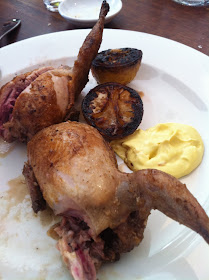
When I was a kid a simple snack after school would be some plain boiled meat dipped in soy sauce. On rare occasions, if it was a casual dinner in front of the TV this would be supplemented with a bowl of rice and some greens for a full meal. My sister and I would clash chopsticks over the most tender morsel and soy sauce would inevitably splash as I dived in, piece after piece. It sounds dull, but it was homely food, comforting in its simplicity.
The boiled meat was a result of the cauldron of soup. This soup is made for the family mealtimes to supplement several dishes served, and is usually a clear broth made by simmering pork or chicken with some Chinese aromatics.

Unless you live near a Chinese supermarket, this type of soup is going to be pretty inaccessible so I apologise in advance. I also apologise if you do make it and you are expecting big flavours which are typical of my recipes; this it is not. Clean and nourishing, the soup with the many dishes you eat at a Chinese dinner is designed to cleanse the palate and aid digestion. The various herbs used all are said to have unique nourishing properties.
I bought a packet of soup herbs neatly separated off into sections, and from what I can gather it consisted of dried red dates (jujubes), astragalus (!), dried goji berries, dang gui (?!) and fox nuts. I only recognise them by sight but before you start backing off, wondering what the hell I've gotten you into,
this nifty guide shows you what they are and what they look like. They add various notes to the soup, from a slight medicinal aniseed twang to sweetness.

Often chunks of carrot are dropped into the soup to simmer with the meat to add sweetness, but my favourite vegetable is winter melon. It is sold already cut and wrapped in clingfilm, labelled 'tong gua'. The dark skin is peeled off, seeds in the middle discarded and the flesh cubed and simmered with the meat. Much like our beloved daikon, the melon takes on a mellow flavour (i.e. of not much) and becomes soft, silky and juicy in the mouth. I love it. The Chinese believe the winter melon has cooling properties, so we ate it a lot if we ever had bouts of rich, fatty or deep fried food. If you can't get hold of any, daikon is a good substitute.

Meat should be on the bone for maximum flavour. I favour pork or chicken for these types of soup; beef and lamb can be just too strongly flavoured.
Having just read this post back I haven't sold this poor soup very well. But it really does do the trick; feeling run-down, tired and a little jaded from over-indulgence, this soup revived my spirits.
Pork & Winter Melon SoupServe 4 as part of a Chinese meal,
or 2 servings on its own300gr meaty pork on the bone - I used hock
300gr daikon, white turnip or winter melon
A handful of dried goji berries (ones from health shops are usually sweetened for snacking - check they aren't if you buy them there)
An assortment of Chinese herbs, as detailed above - A small handful of each
Soy sauce, to taste
Bring a pot of water to boil and blanch the pork hocks for a few minutes. Chuck the water out and rinse the hocks and the pan - this reduces the scum that rises to the surface. Place the hocks back in and cover just with water - you want about half a litre - bring to a gentle simmer. Put half of the soup herbs in and simmer gently for 2 hours with the lid half on.
Remove the hocks and strain the stock into a saucepan. Remove the meat from the hocks and set aside, discarding all the fat and sinew. Add the bitesize chunks of which ever vegetable you use plus the rest of the stock ingredients and place the lid on. Winter melon will take less time (around 15 minutes) than turnip (around 30 mins).
Towards the end, add the meat back in to warm. Serve with a few drops of soy sauce for seasoning.
 After finding sorrel at Brockley Market, I then had to find something to do with it. The leaves are light green in colour and when eaten raw, they taste sharp and intensely sour. I'm told that this flavour is caused by oxalic acid which in large quantities is poisoning, so don't go munching kilos of the stuff.
After finding sorrel at Brockley Market, I then had to find something to do with it. The leaves are light green in colour and when eaten raw, they taste sharp and intensely sour. I'm told that this flavour is caused by oxalic acid which in large quantities is poisoning, so don't go munching kilos of the stuff. The sauce was made very simply by wilting the sorrel leaves, adding double cream and thickening with an egg yolk. Sorrel turns brown very quickly when cooked which makes for a rather unattractive sauce. Tasty though, with the creamy lemon-like flavour working well with the oily fish. Just a handful of steamed new potatoes and a tomato salad was all it needed.
The sauce was made very simply by wilting the sorrel leaves, adding double cream and thickening with an egg yolk. Sorrel turns brown very quickly when cooked which makes for a rather unattractive sauce. Tasty though, with the creamy lemon-like flavour working well with the oily fish. Just a handful of steamed new potatoes and a tomato salad was all it needed.


























